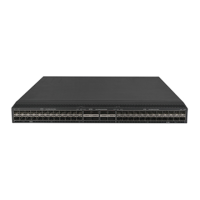8
Restrictions and guidelines for many-to-one VLAN mapping in dynamic IP address
assignment environment
To ensure correct traffic forwarding from the service provider network to the customer network, do
not configure many-to-one VLAN mapping together with uRPF. For more information about uRPF,
see Security Configuration Guide.
To modify many-to-one VLAN mappings, first use the
reset dhcp snooping binding
command to clear the DHCP snooping entries.
Many-to-one VLAN mapping in dynamic IP address assignment environment tasks at a
glance
To configure many-to-one VLAN mapping in dynamic IP address assignment environment, perform
the following tasks:
1. Enabling DHCP snooping
2. Enabling ARP detection
3. Configuring the customer-side port
4. Configuring the network-side port
Enabling DHCP snooping
1. Enter system view.
system-view
2. Enable DHCP snooping.
dhcp snooping enable
By default, DHCP snooping is disabled.
Enabling ARP detection
1. Enter system view.
system-view
2. Enter VLAN view.
vlan vlan-id
3. Enable ARP detection.
arp detection enable
By default, ARP detection is disabled.
You must enable ARP detection for the original VLANs and the translated VLANs.
Configuring the customer-side port
1. Enter system view.
system-view
2. Enter interface view.
{ Enter Layer 2 Ethernet interface view.
interface interface-type interface-number
{ Enter Layer 2 aggregate interface view.
interface bridge-aggregation interface-number
3. Set the link type of the port.
port link-type { hybrid | trunk }
By default, the link type of a port is access.
4. Assign the port to the original VLANs and the translated VLAN.
{ Assign the trunk port to the original VLANs and the translated VLAN.

